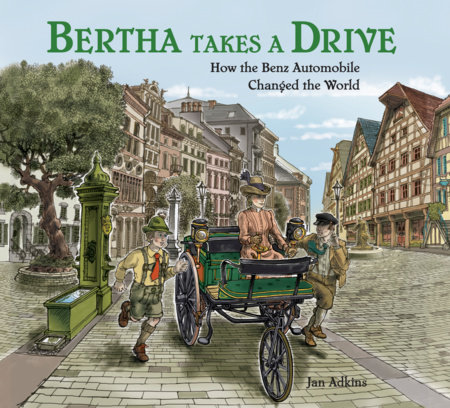

Bertha Takes a Drive
By Jan Adkins
Illustrated by Jan Adkins
By Jan Adkins
Illustrated by Jan Adkins
By Jan Adkins
Illustrated by Jan Adkins
By Jan Adkins
Illustrated by Jan Adkins
Category: Children's Nonfiction
Category: Children's Nonfiction

-
$17.99
Oct 03, 2017 | ISBN 9781580896962 | 5-8 years
-
Oct 03, 2017 | ISBN 9781607347545 | 5-8 years
YOU MAY ALSO LIKE

Where Is Yellowstone?

My Little Golden Book About Vikings

Julia Child: A Little Golden Book Biography

Pope Francis: A Little Golden Book Biography

Steven Spielberg: A Little Golden Book Biography

Martha Stewart: A Little Golden Book Biography

Jacques Pépin: A Little Golden Book Biography

Look and Cook Breakfast

National Geographic Kids 5-Minute Dinosaur Stories
Praise
Over the river and through the woods, to grandmother’s house we go; we steal father’s car, we are going quite far, and mother cooks up the whole show. In the town of Mannheim in Germany, in 1888, Bertha Benz decides to take her husband’s car, the Benz Motorwagen, to grandmother’s house, 60 miles distant in the town of Pforzheim, on roads that were more suited for—to all intents and purposes likely made by—sheep, horses, goats, and cows. Emperor Wilhelm II and the church are not amused by the self-propelled Motorwagen, so Bertha is out to prove them wrong. Bertha and her two sons push the car out of the garage in the early morn, but as they motor along, they meet up with internal-combustion-engine problems that the ingenious Bertha—who had worked with her husband to build the car—solves: she invents the brake shoe along the way, made for her by a cobbler. Adkins tells the tale with brio and dash and illustrates it with nifty, time-gone-by details like roadside alms boxes (hello, toll roads), springs disgorging through gargoylelike face into basins to refresh weary travelers, and naphtha as fuel. The artwork is mostly pleasing, with 1888 European countrysides and villages. The characters’ faces are often obscured by hat brims; when doffed, they often reveal unsettlingly wooden expressions. The story is a hoot of ingenuity and an exhilarating tip of the hat to unsung women heroes, and Adkins has a good time telling it. Even though grandmother meets the Motorwagen with the same disgruntlement as the emperor, everybody else cheers the contraption’s epic voyage.
—Kirkus Reviews
Adkins presents a whimsical episode from automobile history. Bertha Benz, business partner and wife of Karl Benz, was the first person to embark on a long-distance car trip. It’s 1888 and Karl Benz’s Motorwagen is forbidden by the then–German emperor and the church. However, Bertha is not deterred, and she, along with her two teenage sons, sets out on a journey that will change the world, proving once and for all that the Motorwagen should be celebrated and not banned. But faced with bumpy roads, mechanical problems, and skeptics, Bertha and the boys will have to do some ingenious thinking in order to pull the stunt off. Adkin’s narrative is engaging and complimented by the richly detailed illustrations. Although a lot of subject-specific vocabulary is used regarding the vehicle, most of it is explained within the text. There is no date mentioned in the story; however, there is a time line marking Bertha’s drive and several other momentous occasions in the evolution of cars. There are also diagrams of the Motorwagen and its engine, an author’s note, and a map showing where Bertha traveled. The author’s note is written in a kid-friendly language, but the time line is wordy and difficult to follow. A few period-specific terms such as apothecary and garters are used without explanation, but overall this adventure from a vastly different time period is well told for contemporary readers. VERDICT Not a must buy, but an intriguing story for readers interested in the history of cars or joyful true-life escapades.
—School Library Journal
In 1888, Bertha Benz made the first long-distance auto trip (60 whole miles!) without the knowledge or permission of the kaiser, the church, or her husband, Karl (of Mercedes-Benz fame). It certainly wasn’t smooth sailing, but every time something went wrong, Bertha figured out how to fix it. Example: clearing a clogged fuel line with a hat pin. She wanted to show that “the Motorwagen” wasn’t a toy, and thanks to her determination and marketing savvy, she changed the way most of us travel. Digitally rendered art clearly sets the scene in nineteenth-century Germany and depicts the journey from various visual perspectives. Back matter includes an illustrated time line of car history, diagrams of the artist’s interpretation of the vehicle and its motor, and an afterword (though the only source cited is a vague reference to YouTube). This third-person account of a brave, smart woman ably illustrates a key moment in early automobile development, which had a significant impact in legitimizing car travel forever.
—Booklist Online
Bertha Benz was a creative, determined, and brave woman living in the late 1880’s in Germany with her husband and four children. Bertha’s husband had designed the Benz Motorwagon III and Bertha worked with him learning the mechanics of the automobile. Bertha decided to prove that the Benz Motorwagon III was fit to travel at least sixty miles on the unpaved roads, traveling the distance with her two sons. Bertha “showed” her skills as an inventor, mechanic, and determined woman as she traveled in the automobile. Readers will experience traveling the journey with Bertha and her two sons in one of the first automobiles invented. The journey continued with Bertha as she demonstrated her skill as an inventor and mechanic when she used a hatpin to clean the fuel line. She was credited with inventing “brake pad linings” as she realized the brakes needed linings to prevent them from pressing against the wheel rims. Readers can visualize how the automobile emerged into the cars of today comparing the diagrams of the engines with engines today. Jan Adkins is the author of more than forty books for children and writes a regular feature for “Wooden Boat”. His illustrations for the book are from photographs taken during the 1880”s. In “Looking Back Writing Forward” included in the Appendix, the author relates his journey in recreating Bertha’s view of the world by studying the history of the era. There was no documentation as to Bertha’s actual words so the author wrote the story as he “imagined” what Bertha would say. The Appendix includes a time line of the Automobile Evolution from 1880 to the present time and a diagram of the Benz Motorwagon III. This book exemplifies STEM as it embraces real world design, innovation, and invention with the engineering of a new product.
—NSTA Recommends
21 Books You’ve Been Meaning to Read
Just for joining you’ll get personalized recommendations on your dashboard daily and features only for members.
Find Out More Join Now Sign In










